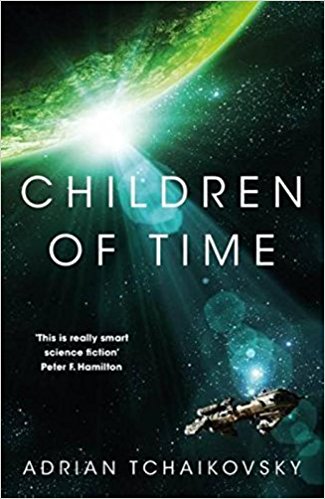
Book Details
Genre: Science Fiction, Futuristic
Ages: 15+
Awards: Winner of the 2016 Arthur C. Clarke Award
Publisher: Pan
Buy From amazon India
Buy From amazon USA
Plot Synopsis
The Children Of Time by Adrian Tchaikovsky, is a story of one dying civilization and another burgeoning one. While the actions of the members of the former are governed by despair, the members of the later act on hope.
Most of the story, follows the two civilizations, through the same period of a few millenia. The civilizations are isolated from each other, until their final clash towards the end of the book.
The first is a civilization of humans. The human race reached the pinnacle of it’s technological prowess, developing amazing and durable technology, but in the process they destroyed the planet and infighting led to chaos and anarchy. The later generations are, initially, in awe of the technology, their ancestors created. They use, and scavenge for, the technology of their ancestors, which they do not really understand.
In the mean time, the planet and its population continue to decline. As the complete annihilation of the human race becomes evident, the humans grow to resent their ancestors. Finally a few hundred of them leave on a spaceship called the Gilgamesh aka Gil, to search for other planets, they believe their ancestors successfully terraformed, and now inhabit, far far away. It is a Hail Mary pass, that few really think will work out, but they are out of options. The crew is in stasis, during the course of the journey, that lasts a couple of thousand years.
The planet the Gil is headed towards, is indeed a terraforming project, but the scientists in charge of the project, had strong disagreements and destroyed each other.
One Dr. Kern, was able to escape in a stasis pod, and she hopes to complete the experiment, which is her one sole obsession. Dr. Kern's experiment involves, populating a terraformed lush green world with monkeys, infected with a nano-virus. This nano-virus is supposed to speed up the process of evolution, and create a new race of intelligent humans who evolve to live in harmony.
Dr. Kern periodically checks on her experiment, and is frustrated by it's results. The progress seems slower and much more confusing, than she had expected. What Dr. Kern does not know, is that the monkeys were destroyed, but the nano-virus was not. It latched on to various other species, but worked best with certain spiders, who are building a civilization.
How far can the spiders advance in creating a technologically advanced society? What will happen when the desperate space-faring humans clash with a society of spiders and their completely alien technology? Read the book to find out.
What I Liked About The Story
Many science fiction books, TV shows and movies have aliens. But they are usually humanoid, and their technology is, usually, either a regressive, or advanced form of our own technology. But the aliens here are earth spiders undergoing an accelerated evolution on a different planet. So they do not think like humans at all. They think like spiders. Their technology is not based on metals but on silk. Their communication is not verbal but through vibrations in silk threads. The detailed and coherent description of the spider technology in the book is fascinating. Their computers are not based on electronics but on biotech.
The accelerated evolution, allows the author to take us through various stages of the civilization. Every time the civilization encounters a crisis, there is a sudden surge in technological or social development. Those who can change and think outside the box, are best suited to usher in a new era of progress.
The social issue that was highlighted was feminism, but in reverse, because, among spiders, females are dominant. This appealed to me personally, because I write about a lot of feminist issues.
The spider philosophy, is to conquer an enemy or problem, not by destroying it, but by studying it carefully, understanding the underlying threat and then tweaking it minimally, in a way that turns the threat to an advantage and integrating it in to their society. Each crisis is turned in to a learning experience that teaches them more about the external world, as well as something about themselves.
The spiders are strongly motivated by empathy in their actions, as the nano-virus, that is the driving force of their evolution, will survive best, if the spiders and other creatures the nano-virus has infected on the planet, act on empathy.
The interactions between the humans on the ship, and how they all react under stress, seems realistic, encompassing various types of human personalities and traits such and loyalty, practicality, curiosity, leadership, greed, fear etc.
The asymmetric relationship between the ship born civilization, and the original crew they revere and yet vastly outnumber is interesting too.
Some Other Thoughts
When I first started reading the book, I found the whole spider business a little icky. But I had read Guns Of The Dawn by Tchaikovsky before and was floored by his nuanced take on war in that book. Set in a Jane Austen like atmosphere, the characters were well developed, the plot was gripping, and the message was powerful.
Based on my past positive experience with the author, I decided to give this book a chance, despite my initial misgivings, and I was not disappointed. The writing is intelligent, the civilization of the spiders is unique and painstakingly developed in great logical detail, the plot is gripping, and the ending is unusual, but fitting.
Spinning the web of civilization with empathy!
Thanks PlusMinus’N’More, for everything I learned from you about reviewing books.